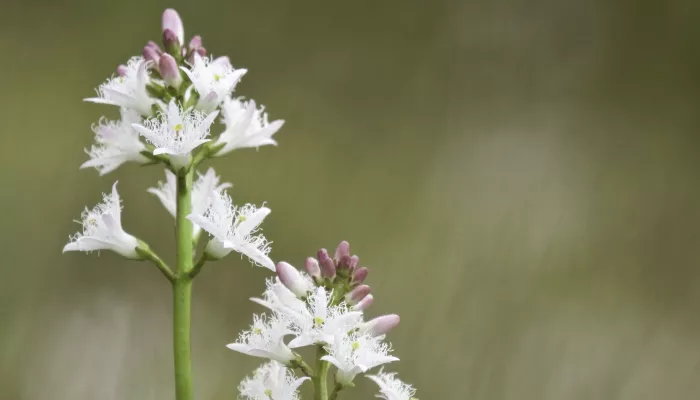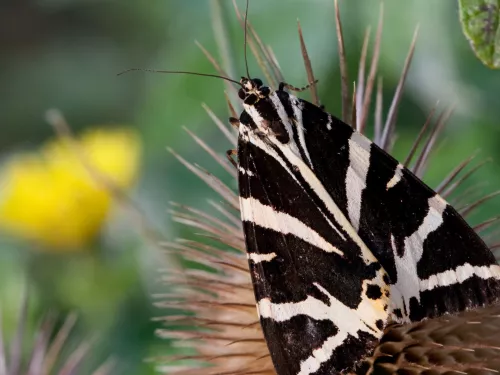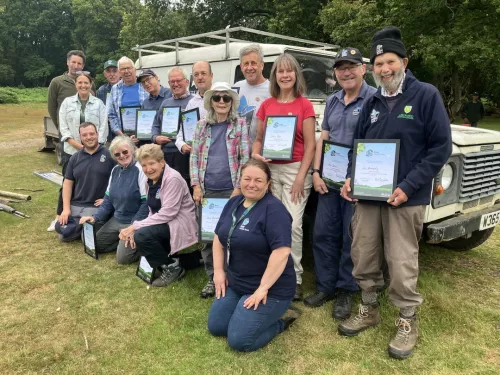
Meet the herd – the eight wild bison on a wilding journey in Canterbury
Since bison were released into West Blean and Thornden Woods on the outskirts of Canterbury, they have not only transformed the landscape but significantly grown in number.

Some birds manage two broods in a season. In mid-May I watched a young treecreeper being fed by a parent, the fledgling clinging to the trunk of an oak tree, always facing upwards, the parent flying in with a beak full of insects extracted from crevices in tree bark with its slender curved beak. Both parents will feed the chick for up to 16 days before turning to produce a second brood. Treecreepers can’t climb downwards so learn to fly down to the base of trees and work their way back up foraging for food.
Another welcome return in May was the frilly white flowers dasht over slightly with a wash of light carnation (John Gerard) of the bogbean, Menyanthes trifoliata, in the bog near Chapel Lane. The flowers, looking, Sarah Raven says, like frayed nylon string, will continue through June. The fringed inside of the petals probably prevents insects too small to be effective pollinators from reaching the nectar. The elliptic leaflets, in threes, resemble those of broad beans. Bogbean’s floating mats provide egg laying, perching and roosting sites for adult dragonfly and damselfly, whose nymphs then climb up the stems from the water ready for their metamorphosis into adults. Native in sunny bog, marsh and shallow water around the north of the northern hemisphere, and tolerant of a wide range of water chemistry, it is becoming rare in Kent as more land is drained. In many cultures flour from the roots was a starvation food; it was used as cure for scurvy and other ailments; the bitter leaves flavoured beer and schnapps, and were rolled with coltsfoot leaves into cigarettes. Two types of flower are produced, with either a short stigma and long stamens or long stigma and short stamens, which as Charles Darwin discovered through thousands of experiments, promotes cross-fertilisation and optimum production of viable seed, promoting the survival of the species.

There is now so much to look for on the Heathland. On 10 May Neil Burt recorded “green and greater spotted woodpeckers, chiffchaffs, blackcaps, 7 garden warblers (4 singing), 2 cuckoos (male & female both calling), common buzzard, sparrow hawk with prey, male bullfinch, a hobby heading north, a singing male nightingale with brief flight views, plus lots of linnets and yellowhammers.” To that list Area Manager Ian Rickards adds whitethroat, nuthatch, green tiger beetles, orange tip butterfly and broad bodied chaser (dragonfly). In June look and listen also for the lizards, myriad insects, more butterflies and moths and the wonderful southern marsh and heath spotted orchids. And as the volunteers, anxious to get back to work, well know, the bloomin’ bracken and birch are growing well!
Ian confirms that visitors are still welcome to visit Hothfield Heathlands as part of their daily exercise. We have taken most catches off gates so that you can open without using your hands. Remember that there is still livestock on site so all gates still need to be left closed. Trails are signposted and marked on entrance maps, as is the location of livestock. The noticeboard down the main slope from the Cades Road car park gives recent wildlife sightings. Please keep dogs in check, especially around children and livestock, and away from the scrub, heather and undergrowth where they will disturb sensitive wildlife. Please remove dog mess, including in the Triangle compartment and take your general litter home. Be tick aware for dogs and humans throughout the summer; guidance is available here.

Since bison were released into West Blean and Thornden Woods on the outskirts of Canterbury, they have not only transformed the landscape but significantly grown in number.

Margery Thomas, Hothfield Volunteer and regular columnist looks at the lack of butterfly sightings in recent months, the work volunteers are doing to remove bracken and how this all impact the wider management of the last remaining fragments of heathland…

By August, floral glory has passed from the orchids (heath spotted, southern marsh and a few large hybrids) to the heather or ling. As ever, we hope for a protracted display of purple in the heathy areas, which is likely if the cool nights persist. Orchid…